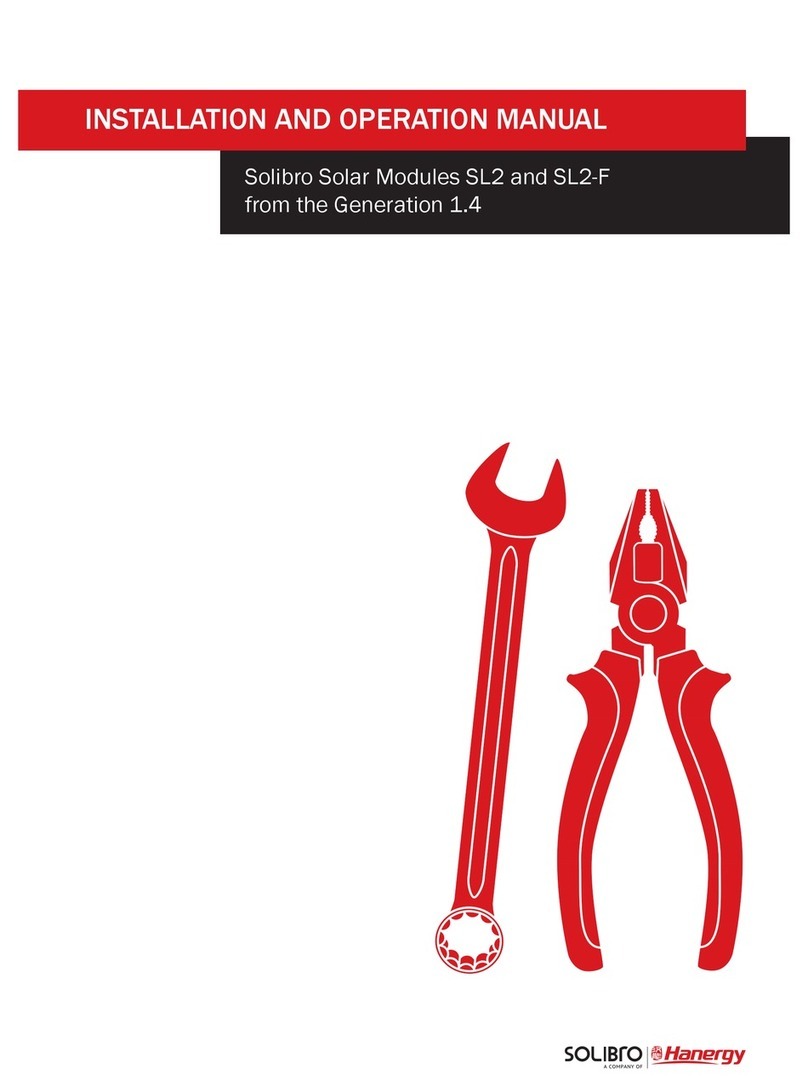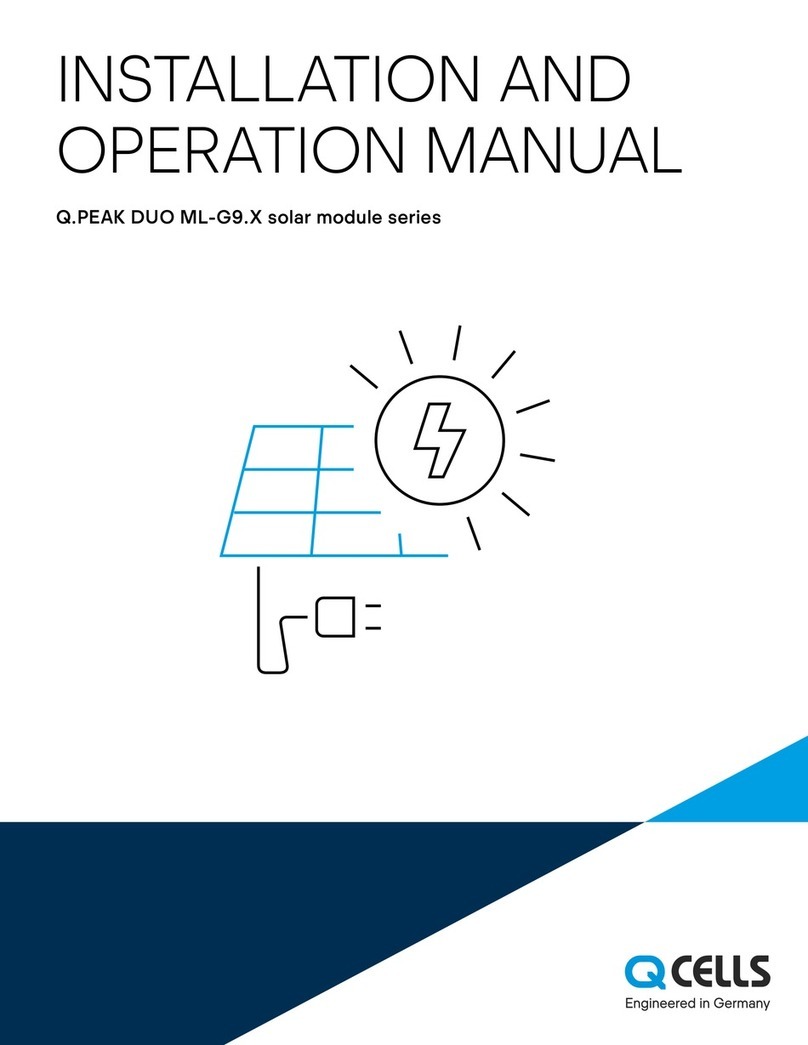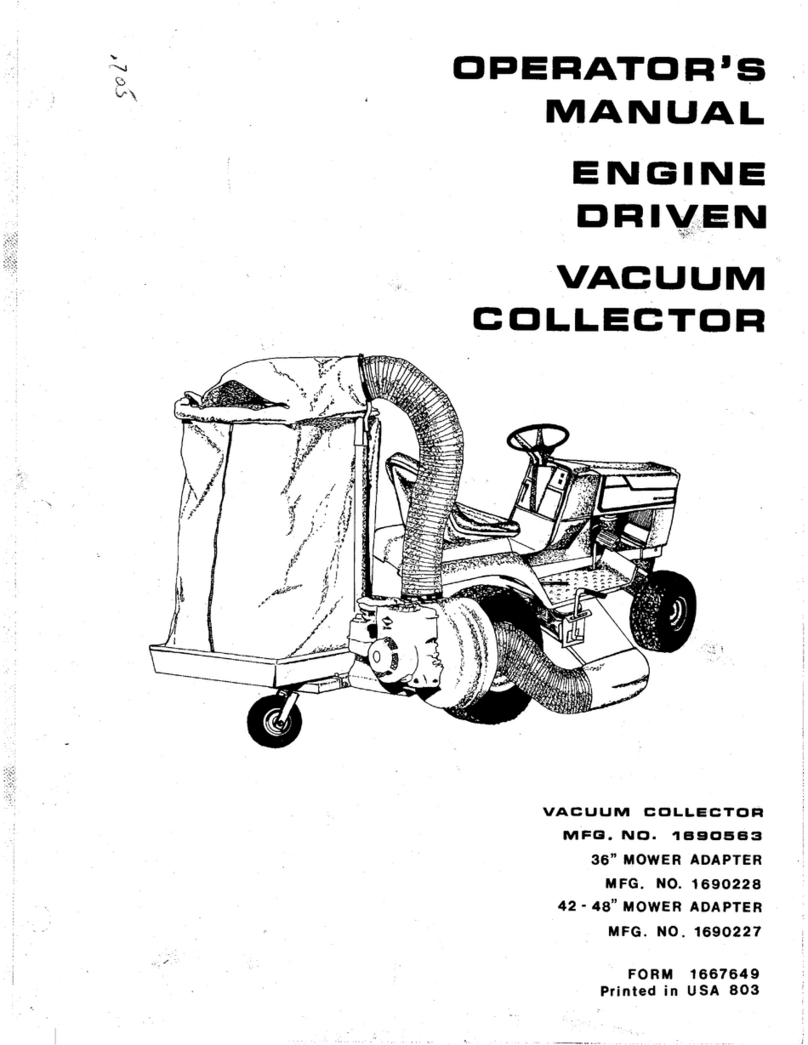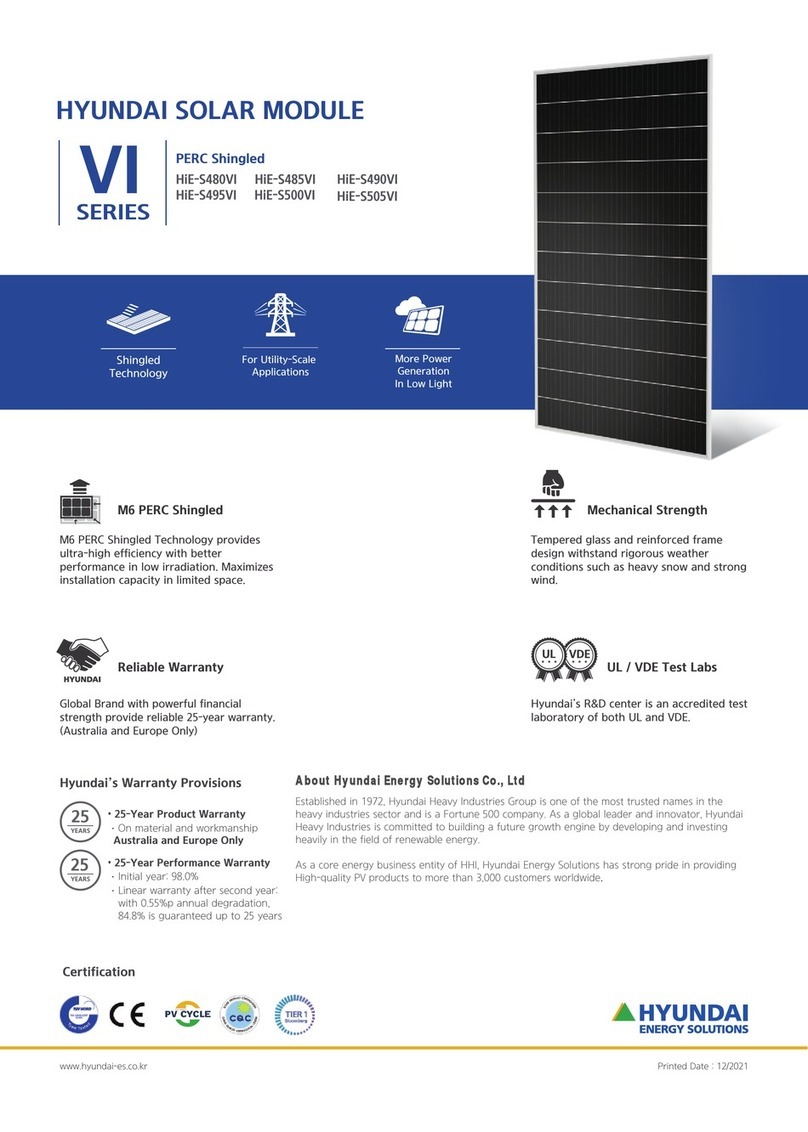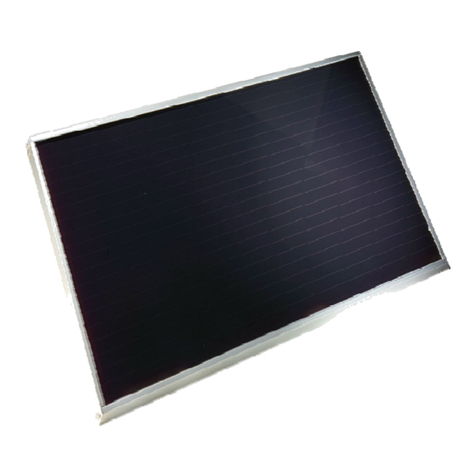Solibro SL2 User manual

INSTALLATION AND OPERATION MANUAL
Solibro Solar Modules SL2 and SL2-F
of the Generation 2.1 and 2.2

2
InstallatIon and oPERatIon ManUal FoR sl2 solaR ModUlEs oF tHE GEnERatIon G2.1 and G2.2
1 INTRODUCTION 3
2 PLANNING 4
2.1 Technical data 4
2.2 Requirements 5
2.3 Mounting variants 8
2.4 Electrical layout 10
3INSTALLATION 11
3.1 Safety and transport 11
3.2 Preparation for installation 13
3.3 Module installation 14
4 ELECTRICAL CONNECTION 15
4.1 Safety 15
4.2 Safety during electrical installation work 16
4.3 Module connection 16
4.4 After the installation 17
5 GROUNDING 18
5.1 Functional grounding of the negative pole 18
5.2 Potential equalization of frame 19
6 FAULTS 19
7 RECYCLING 19
8 CLEANING AND MAINTENANCE 20
9 ADDITIONAL INFORMATION 21
DOCUMENT REVISION 3
This document is valid from January 2017 for the following product ranges:
SL2 and SL2-F solar modules of the product generation G2.1 and G2.2.
Changes to the technical parameters and design reserved. The data sheets and customer information current at the point in time at which the relevant module was manufactured apply
for the carrying out of installation, mounting or maintenance work on the solar modules.

3
InstallatIon and oPERatIon ManUal FoR sl2 solaR ModUlEs oF tHE GEnERatIon G2.1 and G2.2
1 INTRODUCTION
Validcountry-speciclaws,regulationsandrequirementsfor
planning, installation and operation of solar power plants and
working on the roof.
Valid international, national and regional regulations, in par-
ticular regarding the installation of electrical equipment and
systems, on working with direct current and regulations of the
responsible energy supply company regarding parallel opera-
tion of solar power plants.
Accident prevention regulations.
Regulations of the Bau-Berufsgenossenschaft (employers' li-
ability insurance association) (e.g. use of insulated and dry
tools).
Never use light concentrators (e.g. lenses) to increase the
output of the module. The module may be damaged as a
result.
PERSONNEL QUALIFICATIONS
Operator and installer are responsible for ensuring that the instal-
lation, maintenance, repair and dismantling work is only carried
out by trained specialists.
VALIDITY
This manual only applies for solar modules from Solibro GmbH.
Solibro assumes no liability for damage resulting from failure to
observe these instructions.
¼Note the wiring and dimensioning of the system.
¼The observance of all necessary safety regulations when
laying out and installing the system are the responsibility of
the installer of the system.
This manual does not form a legal responsibility on the part of
Solibro. Solibro only accepts liability within the realms of the con-
tractual agreements or in the context of accepted guarantees.
Solibro accepts no responsibility beyond the correct function and
safety of the modules.
¼The manuals for the other system components must also be
complied with.
¼Ifyourquestionsarenotansweredinsufcientdetailinthis
manual, please contact your system supplier or our Product
Serviceintherstinstance.
Further information is available on our website
www.solibro-solar.com
APPLICABLE DOCUMENTS
This installation manual is only valid in conjunction with the follow-
ing technical information.
DOCUMENT TYPE
Product data sheet
List of approved clamps and mounting systems
Packaging and transport information
Installation instructions for Slide-In
Solar modules from Solibro GmbH (referred to below as Solibro)
allow you to directly transform the unlimited energy provided by
the sun into environmentally friendly electrical energy. To ensure
that you can use the full potential of the Solibro solar modules,
read the following manual carefully and follow the instructions.
Failure to follow the instructions in this manual will make the war-
ranty null and void and can result in injuries and material damage.
This installation manual outlines the process for installing CIGS
solar modules safely.
¼Read this installation manual carefully before carrying out the
installation.
¼Retain the installation manual for the usage life of the solar
modules.
¼Ensure that the operator has access to the installation manual
at all times.
¼Pass the installation manual on to each subsequent owner or
user of the solar modules.
¼Add any additions received from the manufacturer.
¼Comply with any applicable documents.
INTENDED USE
These instructions provide information concerning safety in dealing
with the CIGS quality solar module from Solibro GmbH, as well as in-
structions for installation, mounting, wiring and maintenance.
The manual is valid for SOLIBRO solar modules:
SL2
SL2-F
of the generation 2.1 and 2.2.
SYMBOLS AND LABELS
Symbols and labels are used in this installation manual to make
the instructions quick and easy to understand.
SYMBOLS DESCRIPTION
¼Action with one step or with multiple steps.
▪List
Ensure when carrying out an action, check the result of
an action.
Action is not permitted.
SAFETY REGULATIONS
The operator of the solar module is responsible for ensuring that
all relevant legal regulations and directives are complied with.
¼Solar modules should only be commissioned, operated and
maintained in accordance with the following regulations and
standards:
Installation and assembly manual.
Country-specicregulations,forexample,planningandbuild-
ing laws, operational safety, hazardous goods and environ-
mental protection.
Plant-specicregulationsandrequirements.

4
InstallatIon and oPERatIon ManUal FoR sl2 solaR ModUlEs oF tHE GEnERatIon G2.1 and G2.2
76
76
+3
–1
796.1
789.5 –1
+3
+3
1190 –1
30
+3
1196.6 -1
23
±
0.5
+20
855 –0
+20
735 –0
+20
855 –0
+20
735 –0
7.3±0.5
23±0.5
58
30
58
7.3±0.5
Fig. 1: External dimensions (in mm) and components for SL2 and SL2-F
Fig. 2: Module label SL2 & SL2-F
Components (rear view)
1Junction box
2Module label
3Connection cables
4Connectors (+ and -)
5Grounding points (SL2-F only)
6Drainage holes (SL2-F only)
7Frame (SL2-F only)
PRODUCT LINE SL2 SL2-F
Type unframed framed
Area 0,94 m² 0,95 m²
Weight 16,5 kg 18,0 kg
Max. system voltage Vsys 1000 V 1000 V
Max. reverse current loading capability 4 A 4 A
Junction box Protection class IP67 with bypass diode Protection class IP67 with bypass diode
Connector Renhe 05-6 (electrical contacts protected from unintentional contact, protection against reverse polarity, UV
resistant, weather-resistant from -40 °C up to +90 °C, designed for 1000 V DC and 30 A). Can only be discon-
nected using the RH-01 tool from Renhe.
Fire Rating C C
Positive design load (IEC 61215-2) Up to 1600 Pa* Up to 3600 Pa*
Negative design load (IEC 61215-2) Up to 1600 Pa* Up to 1600 Pa*
Permitted operating module
temperature
–40 °C to +85 °C (–40 °F to +185 °F) –40 °C to +85 °C (–40 °F to +185 °F)
Certicates CE; IEC 61646 (Ed. 2); IEC 61730 (Ed. 1) Application
class A; MCS, UL 1703 (CSA)
CE; IEC 61646 (Ed. 2); IEC 61730 (Ed. 1)
Application class A; MCS, UL 1703 (CSA)
* tested with a safety factor γmof 1.5
SL2 SL2-F
2 PLANNING
2.1 TECHNICAL DATA
76
76
+3
–1
796.1789.5 –1
+3
+3
1190 –1
30
+3
1196.6 -1
23
±
0.5
+20
855 –0
+20
735 –0
+20
855 –0
+20
735 –0
7.3±0.5
23±0.5
58
30
58
7.3±0.5
1
2
34134
5
6
6 6
6
5
5
5
7
2

5
InstallatIon and oPERatIon ManUal FoR sl2 solaR ModUlEs oF tHE GEnERatIon G2.1 and G2.2
2.2 REQUIREMENTS
Installation location
The following information is intended to serve as a guide for
the planner. It cannot cover all of the technical possibilities and
mounting options. Rather, it sets out the minimum requirements
for mounting the modules.
Comply with the following notes on the installation location:
The modules are tested in accordance with IEC 61646, 61730
and UL 1703 for safe use in a moderate climate.
Modules are not explosion-proof devices.
¼Donotoperatethemodulesnearhighlyammablegasesand
vapors (e.g. gas containers, petrol stations).
¼Do not subject the modules to severe chemical stresses.
¼The junction box only has splash protection (IP 67).
¼Do not install the modules in closed rooms.
¼Do not install modules at locations where standing water can
collect.
¼The modules are not suitable for mobile use.
¼Roof-integrated installation (BIPV) is not permitted.
Requirements on the mounting frame
The mounting frame:
fullstherequiredstatic.
corresponds to the local snow and wind load requirements.
is anchored stably in the ground, on the roof or on the façade.
transfers forces occurring on the module to the substructure.
ensuressufcientbackventilationofthemodule.
in combination with a suitable clamp, enables stress-free,
temperature-dependent expansion and contraction of the
module and the substructure.
has electrochemical properties, which prevent corrosion
between different metals.
creates a plane mounting surface to which the modules can be
xed,withamaximumdeviationof3mm/minalldirections
¼The clamps and rail system must be compatible.
¼Ensure that no mechanical stresses (e.g. due to vibrations,
rotations or expansions) are generated on the module.
NOTE!
Ensurethatthesubstructure
isongroundpotential(R≤10Ω).
¼For further notes, see Chapter 3
2 PLANNING
Requirements on the module orientation
Installation in landscape or portrait possible.
Installation with the junction box in the top section of the
module. The connection cables hang down.
The optimal inclination angle of the module depends on the
latitude.
¼Do not seal up the drainage openings.
¼Ensure that rainwater and snowmelt can run off freely.
¼We recommend a minimum inclination of 3°
¼An angle of 20° promotes self-cleaning in the rain
Fire Protection
Observeregulationsandsafetyinstructionsforthereprotection
classicationforrooftopinstallations.Themoduleisratedtore
protectionclassC.Thereratingofthismoduleisvalidonlywhen
mountedinthemannerspeciedinthemechanicalmountingin-
structions. To maintain this rating, the module assembly is to be
mounted overare-resistantroof coveringspeciedforthe ap-
plication.

6
InstallatIon and oPERatIon ManUal FoR sl2 solaR ModUlEs oF tHE GEnERatIon G2.1 and G2.2
Requirements on the clamping system for unframed modules
Only clamp systems approved by Solibro may be installed. The
list of all approved clamps is available at www.solibro-solar.com.
On request, Solibro can test clamp systems and approve them
following successful testing.
¼All contact between the metal of the clamps and the module
glass must be prevented.
¼
Use a suitable silicone-free rubber support plate between the
module and the substructure or clamps. The plate must be at
least 3 mm thick on the sides that are in contact with glass.
¼The rubber mixture used as insulation material must have a
volume resistivity of at least 1*1014Ω*cm,inaccordancewith
ASTM D257.
¼The material hardness of the rubber support plate should lie
between 45 and 75 on the Shore A scale.
¼Ensure that the rubber mat is in place completely and does
not slip.
¼The rubber support plate must be UV and aging resistant for
at least 25 years.
¼Clampwidth:≥120mm.
¼The clamp height of 7.3 mm (module thickness), including the
compression of the EPDM rubbers, may not be fallen short of
in the mounted state.
¼Clamps must not throw a shadow on the active cells.
Distancefromtheglassedgetotherstactivecell
amounts to 16.5 mm (Fig. 3).
¼Comply with the glass inset (Fig. 3):
10–15 mm on the top side of the module
12–16 mm on the bottom side of the module
¼Comply with the side clearance between the edge of the glass
and the inner side of the clamps:
> 1 mm at 25 °C for thermal expansion of the module (Fig. 3)
Ensure that the screw connection does not apply any
additional tension to the module. The modules must be po-
sitionedstrainlessandoat-mounted.Thescrewbetween
theglass/glassmoduleandtheclampshouldbetightened
with the recommended torque of 8 to 10 Nm.
¼See applicable documents “List of approved clamps and
mounting systems”
Fig. 3 Clamping of unframed modules
10–15
12-16
16.5
7.3 ± 0.5
> 1
Clamp (schematic) Glass (module top side)
Rubber Glass (module bottom side)
Active surface
2 PLANNING
All measurements in mm.

7
InstallatIon and oPERatIon ManUal FoR sl2 solaR ModUlEs oF tHE GEnERatIon G2.1 and G2.2
2 PLANNING
Requirements on the clamping system for framed modules
When using framed Solibro products, it is important to ensure that
there is no potential difference between frame and ground. There
are two options available for this:
Option 1: Usage of grounding clamps with grounding function
speciedintheapprovedSolibroclampslist.Onrequest,Solibro
can test clamp systems and approve them following successful
testing.
Option 2: Potential equalization of the module must be done via
one of the grounding holes on the module frame. In that case,
usageofclampswithoutgroundingfunctionisvalidiftheyfull
the following requirements:
Clamp height corresponding to 30 mm frame height.
Clamp depth: 7–12 mm.
Clampswhichfullthestaticrequirementsofthelocation.
Clampswithlong-termstability,whichxthemodulesecurely
on the mounting frame.
Clamps do not deform the frame.
Minimumwidthmiddleclamp:≥40mm
Minimumwidthendclamp:≥40mm
¼See applicable documents “List of approved clamps and
mounting systems”
¼See also information on potential equalization in Chap. 5.2
Fig. 4 Clamping of framed modules
7–12
Clamp Glass (module top side)
Clamp depth Glass (module bottom side)
Module frame Active surface
Frame tape
All measurements in mm.

8
InstallatIon and oPERatIon ManUal FoR sl2 solaR ModUlEs oF tHE GEnERatIon G2.1 and G2.2
2.3 MOUNTING OPTIONS
Approvedclampareasandmountingoptionsforthesolarmodules(topview).Thespecieddimensions(inmm)refertotheclearance
between the module edge and the middle of the clamp. The illustrated mounting variants apply for installation in portrait and landscape
format.
Unframed modules
Mounting with clamps
Insertion prole system
The mounting option described for unframed modules is permitted only with point mounting.
Solibro Slide-In
The mounting option described for unframed modules is permitted with linear mounting.
With all of the options, the module can bend by up to 15 mm at the maximum permissible load. And the glass must not come into
contact with the substructure in this case.
PermissiblecontactareasforSlide-Inandinsertionprolesystems
WhenxingtheSlide-Inandinsertionprolesystems,thepermissiblecontactareasmustbeobserved.Self-cleaningoftheframed
modulesisensurediftheyareinclinedatanangleof≥25°.
Inthecaseofinsertionprolesystems,themodule’sowndeadweightholdsitinposition.Itisvitalthatyoutakeintoaccountthe
dynamic wind loading here, to ensure that the modules cannot not slide out or slip.
Clamp area [x]
Substructure lateral
Point mounting
Clamp area [x]
Substructure longitudinal
Point mounting
Design load
Permissible static
load [Pa]
Test load with
safety factor
γm=1.5 [Pa]*
240 mm ± 25 mm 240 mm ± 25 mm 1,600
1,600
2,400
2,400
Clamping area Substructure
Clamp area [x]
Substructure longitudinal
Point mounting
Design load
Permissible static
load [Pa]
Test load with
safety factor
γm=1.5 [Pa]*
50 mm ± 20 mm 1,600
1,600
2,400
2,400
Consistent linear
positioning throughout
Design load
Permissible static
load [Pa]
Test load with
safety factor
γm=1.5 [Pa]*
1,600
1,600
2,400
2,400
2 PLANNING
xx
L/2
x
≥80

9
InstallatIon and oPERatIon ManUal FoR sl2 solaR ModUlEs oF tHE GEnERatIon G2.1 and G2.2
Framed modules
The listed mounting variants are valid for point mounting and linear mounting.
* TestLoad=γmx Design Load
γ
m≥1.5(observeregionalrequirements)
Clamp area [x]
Substructure lateral
Point mounting
Clamp area [x]
Substructure longitudi-
nal Linear mounting
Design load
Permissible static
load [Pa]
Test load with
safety factor
γm=1.5 [Pa]*
150 mm - 250 mm −3,600
1,600
5,400
2,400
125 mm - 275 mm
150 mm - 275 mm 2,900
1,600
4,400
2,400
100 mm - 300 mm
100 mm - 325 mm
2,250
1,600
3,400
2,400
75 mm - 325 mm
75 mm - 350 mm
1,600
1,600
2,400
2,400
Clamp area [x]
Substructure lateral
Point mounting
Clamp area [x]
Substructure longitudi-
nal Linear mounting
Design load
Permissible static
load [Pa]
Test load with
safety factor
γm=1.5 [Pa]*
40 mm - 100 mm −2,250
1,600
3,400
2,400
40 mm - 160 mm 40 mm - 160 mm
1,600
1,600
2,400
2,400
Clamping area Substructure
2 PLANNING
xx
x
x

10
InstallatIon and oPERatIon ManUal FoR sl2 solaR ModUlEs oF tHE GEnERatIon G2.1 and G2.2
2 PLANNING
2.4 ELECTRICAL LAYOUT
Requirements on the system
You can nd the detailed electrical parameters in the product
data sheet.
¼Only connect modules of the same type and the same power
class.
¼The voltage limitation of the inverter must also be taken into
account in the layout of the string length.
¼Do not operate modules in short circuit.
¼Do not operate modules longer than 90 days in open terminal
voltage.
Safety factor
During normal operation, the module may provide a greater
currentand/orahighervoltagethanthatdeterminedunderstan-
dardized test conditions. A safety factor of 1.25 for ISC and VOC
should therefore be applied when:
Determining the voltage rated values of the components
used,
Determining the current rated values of the cables, the size of
the fuses and dimensioning the controls.
¼The relevant applicable national regulations for the installa-
tion of electrical systems should be applied.
Series connection
Serial connection of the modules is only permitted up to the
maximumsystemvoltagespeciedinthecurrentvaliddatasheet.
Carry out the layout taking into account all working conditions
andrelevanttechnicalspecicationsandstandards.Thiswill
help you ensure that the maximum system voltage, including
the necessary safety margins, is not exceeded.
Parallel connection
¼Only connect modules of the same type and power class.
¼Do not exceed the maximum permissible reverse current as
given in the respective data sheet. In the event of reverse cur-
rents (caused by module defects, ground leakage or shading),
modules can be placed under strain.
In order to safely account for reverse currents, we recommend the
following fuse variants:
Layout with limit on the number of strings operated in parallel
Without further measures for current limitation, only a maximum
of 2 strings of modules may be operated parallel on an inverter.
Layout with string diodes
When more than 2 strings are connected parallel, a maximum of
2 strings respectively must be protected against reverse currents
from the remaining system with a shared string diode.
Layout with string fuses
In this case, the modules of each string must be fused with 4 A.
NOTE!
When installing modules from different product revisions, observe
the minimum permitted reverse current loading capability.
INVERTER
Solibro modules must exclusively be operated with inverters
where the negative generator pole must be grounded or its poten-
tial curve must always be positive.
NOTE!
You can nd more information about functional grounding in
Chapter 5.1.

11
InstallatIon and oPERatIon ManUal FoR sl2 solaR ModUlEs oF tHE GEnERatIon G2.1 and G2.2
¼Check the packaging for damage.
¼
If the packaging is damaged, contact the shipping
company
¼Follow the packaging instructions
DANGER! Danger due to electric shock!
¼Do not install damaged modules
¼Report any damage to your dealer immediately
3 MONTAGE
3.1 SAFETY AND TRANSPORT
Leave the modules in the original packaging
right up until installation
Store the modules securely in dry rooms. The
packaging is not weatherproof!
DANGER! Danger due to electric shock!
¼
Cover the modules with lightproof material for the
duration of the installation
§
CN
§
GB
§
I§
D
¼Ensure that the personnel are familiar and
comply with the accident prevention and safety
regulations

12
InstallatIon and oPERatIon ManUal FoR sl2 solaR ModUlEs oF tHE GEnERatIon G2.1 and G2.2
NOTE! Damage to the modules!
¼Never stand on the modules.
¼Do not apply mechanical stress to the modules.
¼Do not drop objects on the modules.
NOTE! Damage to the modules!
¼
Never lift or move the modules by the connec-
tion cables or the junction box.
NOTE! Damage to the modules!
¼Do not stack the modules.
NOTE! Damage to the modules!
¼Do not drop the modules.
3 INSTALLATION
Note! Damage to the modules!
¼
Use glass suction cups to remove and trans-
port modules.
¼Carry the modules vertically.
NOTE! Damage to the modules!
¼Do not put unframed modules down on their
edges without protection.

13
InstallatIon and oPERatIon ManUal FoR sl2 solaR ModUlEs oF tHE GEnERatIon G2.1 and G2.2
3 MONTAGE
3.2 PREPARATION FOR INSTALLATION
DANGER! Danger due to electric shock!
¼Cordon off the installation area.
¼Keep children and unauthorised persons away
from the solar system.
¼Do not carry out the installation alone.
¼Only install modules and components which
are free from damage.
¼Do not add any holes.
Confirmation
letter
NOTE! Damage to the modules!
¼
Changes may only be made to the module,
which have been approved by Solibro in writing.

14
InstallatIon and oPERatIon ManUal FoR sl2 solaR ModUlEs oF tHE GEnERatIon G2.1 and G2.2
90°
¼Position the modules plane.
¼Do not subject modules to mechanical stress.
Max.torsionof3mm/m.
10mm
10mm
Installing unframed modules
¼Please note the requirements on the clamping system out-
lined in Chapter 2.
¼Lay anti-slip protection between the module
clamp and the substructure.
Module clamp
Anti-slip protection
Rubber
Installing framed modules
¼Please note the requirements on the clamping system out-
lined in Chapter 2.
¼Tighten the clamps for framed modules with a torque of 18 Nm.
¼Keep a minimum distance of 10 mm between
neighbouring modules
3 INSTALLATION
3.3 MODULE INSTALLATION

15
InstallatIon and oPERatIon ManUal FoR sl2 solaR ModUlEs oF tHE GEnERatIon G2.1 and G2.2
DANGER! Danger due to electric shock!
¼Insulate exposed cable ends.
¼Only connect cables with plugs.
4.1 SAFETY
DANGER!
Danger due to electric shock!
When disconnecting an electric circuit transporting direct current,
electric arcs can occur that can result in life-threatening injuries.
¼Do not disconnect the cable and plug while they are energized.
¼Do not touch the poles at the same time.
Even at a low illuminance level, a solar module generates electric
current and electric voltage. Sparks and electric arcs can result
from the separation of a closed circuit. This can result in fatal
injury. The danger increases when several modules are connected
in series.
¼Please note that the entire open circuit voltage can also be
on even with low level light irradiation.
¼
Comply with the valid regulations and safety instructions for
the installation of electrical equipment and systems.
¼
Undertake the necessary protection and precautionary mea-
sures. In the case of module or phase voltages of more than
120 V, this is outside the extra-low voltage.
¼Work on the inverter and on the cables may only be carried
outbyaqualiedelectrician.
4 ELECTRICAL CONNECTION
DANGER! Danger due to electric shock!
¼Never open the junction box.
¼Do not remove the bypass diodes.
DANGER! Danger due to electric shock!
¼Don‘ttouchlivecontacts/contactareas

16
InstallatIon and oPERatIon ManUal FoR sl2 solaR ModUlEs oF tHE GEnERatIon G2.1 and G2.2
click
DANGER! Danger due to electric shock!
¼
Alwayscomplywiththespeciedtimeinter-
vals from switching off the inverter to starting
further work.
4.2 SAFETY DURING ELECTRICAL INSTALLATION WORK
4 ELECTRICAL CONNECTION
DANGER! Danger due to electric shock!
¼Never disconnect the plugs in energised state.
1. Switch off the inverter.
2. Keep the DCside free with isolators.
3. Cover modules that need to be separated.
DC
SWITCH
OFF
DANGER! Danger due to electric shock!
¼Ensure correct polarity.
¼Ensure that a secure connection is in place
between the plugs. Plugs engage audibly.
¼Do not apply mechanical stress to the cables.
Comply with bending radius (min. 35 mm for
cables on the junction box outlet).
¼
Connectors can only be disconnected using an
RH-01 tool from Renhe
4.3 MODULE CONNECTION
¼
Use solar cables for the connection on the
junction box outlet.
¼
Only connect together connectors of the same
type (Renhe 05-6 connectors on the module
side)
SOLAR
DANGER! Danger due to electric shock!
¼Ensure that all electrical components are in a
correct, dry and safe state.

17
InstallatIon and oPERatIon ManUal FoR sl2 solaR ModUlEs oF tHE GEnERatIon G2.1 and G2.2
4.4 AFTER THE INSTALLATION
4 ELECTRICAL CONNECTION
¼Carry out all necessary safety and functional
tests according to the current state of
technology.
¼Protect the cabling from dirt and wet.¼Ensure that the substructure is on ground
potential:(Groundresistance≤10Ω)
¼Fix the cable properly to the substructure. The
connectors must not lie in water.

18
InstallatIon and oPERatIon ManUal FoR sl2 solaR ModUlEs oF tHE GEnERatIon G2.1 and G2.2
5.1 FUNCTIONAL GROUNDING OF THE NEGATIVE POLE
Solibro solar modules are to be principally protected against nega-
tive voltages with regard to the ground potential on the generator
pole!
In most cases, this is realized by connecting the negative pole of
the array (systems with galvanic separation between the direct
and alternating voltage sides) with the ground potential.
Many inverter manufacturers offer grounding kits for their inverters:
¼Functional grounding of the negative pole
PV system
Functional grounding kit negative
DC/ACinverter
Isolating transformer
Inverter unit
=
~
PV+
PV-
Systems without galvanic separation between DC and AC sides
generally do not meet the requirements for functional grounding.
Ground fault protection
For appropriate protection against DC residual currents, Solibro
recommends selecting inverters with the following functions:
Insulation resistance measurement prior to grid connection
Countermeasures against excessively high residual current
Countermeasures in the event of sudden changes to the
residual current
Depending upon the inverter topology, these functions are the
prerequisiteforinvertersthatfulltheIEC62109-2standard.
As a minimum requirement, it must be ensured that the following
residual currents are not exceeded*:
Module type SL2 (unframed) SL2-F (framed)
Ground-mounted systems/
Utility
max. 2 A max. 2 A
Rooftop systems max. 300 mA max. 1 A
*The valid regulations for personal protection remain unaffected.
5 GROUNDING
In most cases, the fault current limitation is realized via the
grounding kit of the respective inverter manufacturer. A fault
current can be limited by a fuse, a resistor or a RCMU system
(“Residual Current Monitoring Device”). Please contact the in-
verter manufacturer as whether the above mentioned minimum
requirements are met (see table).
Maximum permissible functional grounding resistor
In the event that a resistor is used between the negative pole and
the ground, the size of the resistor may not exceed the following
values:
Modules in series 9 8 7 6 5
RMax [kΩ] 450/n 570/n 745/n 1015/n 1416/n
Modules in series 4 3 2 1
RMax [kΩ] 2280/n 4055/n 9125/n 36505/n
n ...Number of parallel connected strings per inverter
For safe functional grounding:
¼Use an inverter that is suitable for functional grounding.
¼Ground negative generator pole with a grounding kit recom-
mended by the inverter manufacturer; with which the ground-
ing corresponds to the requirements named above.
¼Observe the regulations of the inverter manufacturer.
¼In the case of direct grounding, ensure that the grounding
presents no danger to persons.
¼Observepersonalprotectionandreregulations.
Pleasecontactourcustomerservicetondaninvertersuitable
for your application.

19
InstallatIon and oPERatIon ManUal FoR sl2 solaR ModUlEs oF tHE GEnERatIon G2.1 and G2.2
5.2 POTENTIAL EQUALIZATION
When using framed Solibro products, it must be ensured that
no potential difference between the frame and the substructure
exists. There are two options available for this:
Option 1:
Usageof grounding clampswithgroundingfunction speciedin
the approved Solibro clamps list. On request, Solibro can test
clamp systems and approve them following successful testing.
Option 2:
If using clamps without grounding function the potential equaliza-
tion of the module must be done via one of the grounding holes
on the module frame.
Establish the potential equalization of the framed module via a
self-tapping screw (in accordance with DIN 7981, material: A2,
size: 4.2 mm x 16 mm) on one of the four grounding holes marked
in Fig. 1, page 4 (marked with a ). Attach the screw as shown in
thegurebelow.
¼See Figure 1 for grounding holes
¼Achieve potential equalization with a self-tap-
ping screw on the grounding points.
Stainless self-tapping screw
Stainless washer (cable lug)
Stainless serrated lock washer
Module frame
Grounding point
6 FAULTS
DANGER!
Danger to life due to electrical shock and re with
damaged modules!
¼
In case of problems or damaged modules (e.g. glass breakage,
damaged cables) please contact your installer immediately.
The installer must ensure that the module is removed from
the system as soon as possible.
7 RECYCLING
Do not decommission the module on your own. Commission (in-
struct/engage)aspecialisedcompanyforthispurpose.Dispose
of old modules only in accordance with your national and regional
waste regulation. Ask your local waste authority for options of dis-
posal.
According to the recast of the European Directive on Waste Elec-
trical and Electronic Equipment, the product should not be dis-
posed of with the general household waste.

20
InstallatIon and oPERatIon ManUal FoR sl2 solaR ModUlEs oF tHE GEnERatIon G2.1 and G2.2
¼Remove soiling from the substructure (leaves,
bird nests etc.).
6 CLEANING AND MAINTENANCE
Solibro solar modules stand for a long useful life and minimal
maintenance effort and expense. Light soiling is usually washed
away by rain. Cleaning is necessary when the module is shaded
by heavier soiling (e.g. plants, bird droppings). This can reduce the
output of the module.
Maintenance
¼Anannualmaintenancebyaspecialistrmisrecommended
Securexingandcorrosionresistanceofallsystemcom-
ponents.
Secure connection, cleanliness and integrity of all electri-
cal components.
Cleaning
Clean the modules as follows:
¼Remove snow and ice without exerting force (e.g. with a
broom).
¼Do not scratch off the dirt.
¼Rinse dirt (dust, leaves, bird droppings etc.) off with lukewarm
water.
¼Remove stubborn dirt with a damp and soft cloth or a sponge.
¼Dampen stubborn dirt with a soft cloth or sponge and remove
carefully.
¼Do not use abrasive cleaning agent, tenside, scrapers or
devices with high water pressure.
If necessary, it is possible to use isopropyl selectively for stub-
born dirt:
¼Follow the safety instructions on the isopropyl packaging.
¼Do not let isopropyl run into the space between the module
and the frame or into the module edges.
NOTE! Damage to the modules!
Do not clean the module with water if there is a risk of frost.
WARNING ! Danger of injury from heated modules!
Only clean the modules when the module temperature lies
between 10 °C and 30 °C, e.g. in the early morning or late evening.
Don’tcleandamagedmodules.Thiscancauseanelectricshock.
0°
NOTE ! Damage to the modules!
¼Do not clean the module with water if there is a
risk of frost.
¼Remove dirt with lukewarm water, brush or a
soft cloth.
¼Do not use tenside, scrapers or devices with
high water pressure.
Other manuals for SL2
1
This manual suits for next models
1
Table of contents
Other Solibro Solar Panel manuals
Popular Solar Panel manuals by other brands

Conrad
Conrad TPS-102-6 operating instructions

JIANGYIN TITANERGY
JIANGYIN TITANERGY TT-ADJUSTABLE TILT LEGS installation manual

SOMFY
SOMFY 3.2W Solar Panel instructions
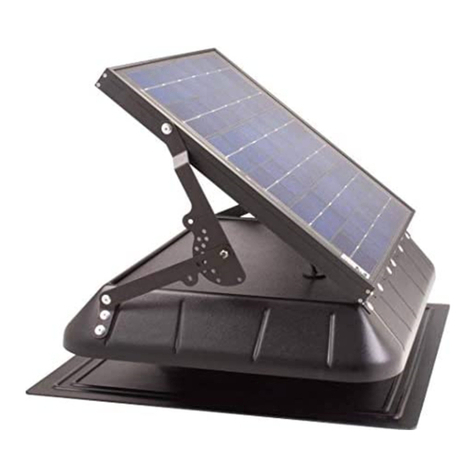
SRS Labs
SRS Labs FB 1650 TLT FT installation guide
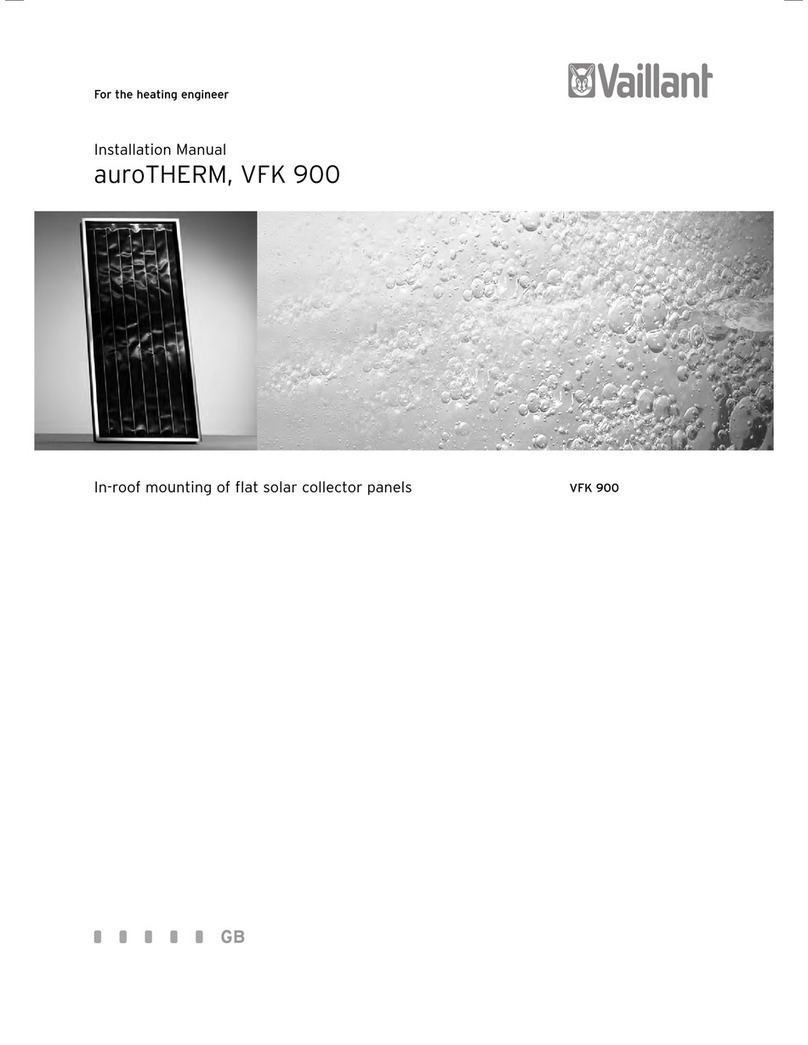
Vaillant
Vaillant auroTHERM VFK 900 installation manual
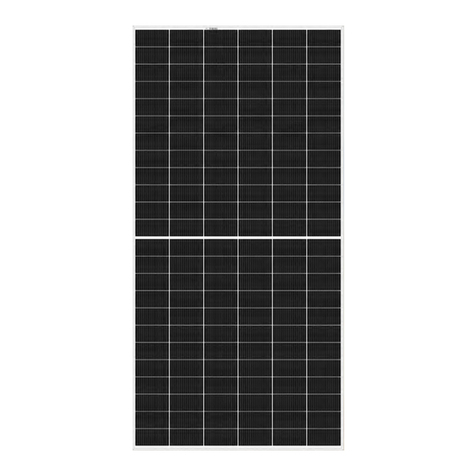
REC
REC Alpha 72 Series installation manual

BETOP
BETOP LS-HB60 Use and care guide

ALZA
ALZA BigBlue B401D manual
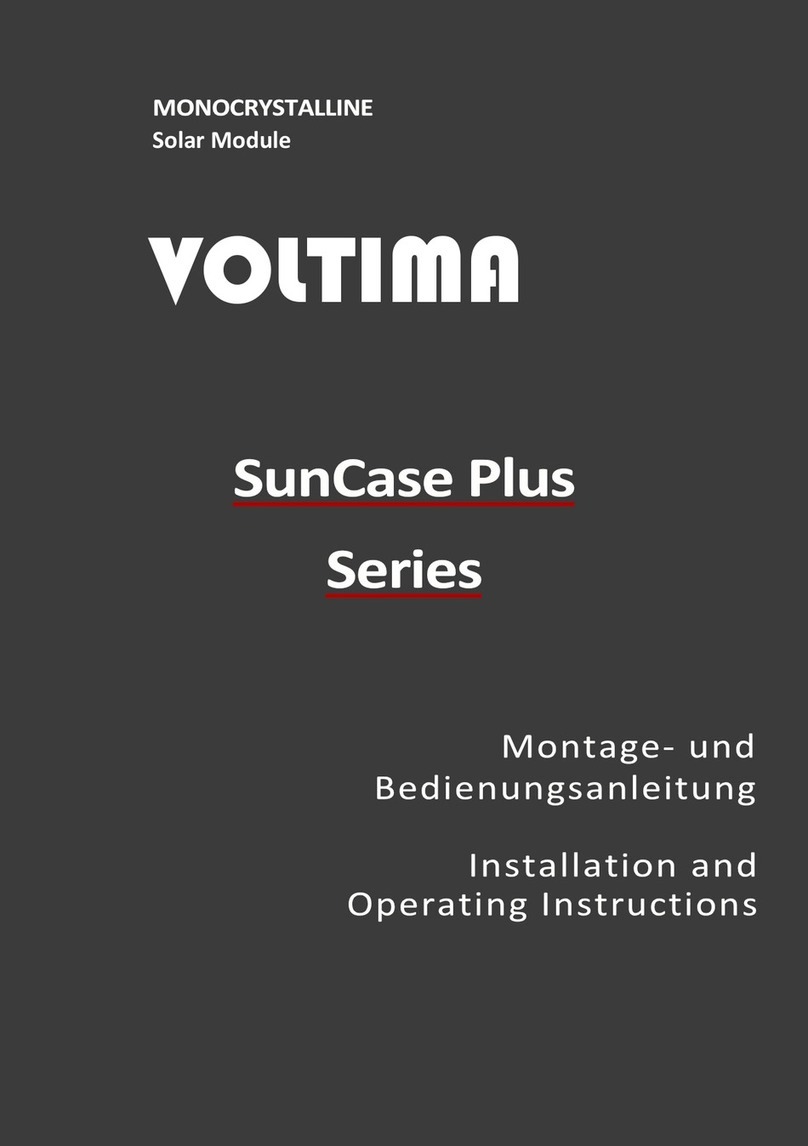
VOLTIMA
VOLTIMA SunCase Plus Series Installation and operating instructions
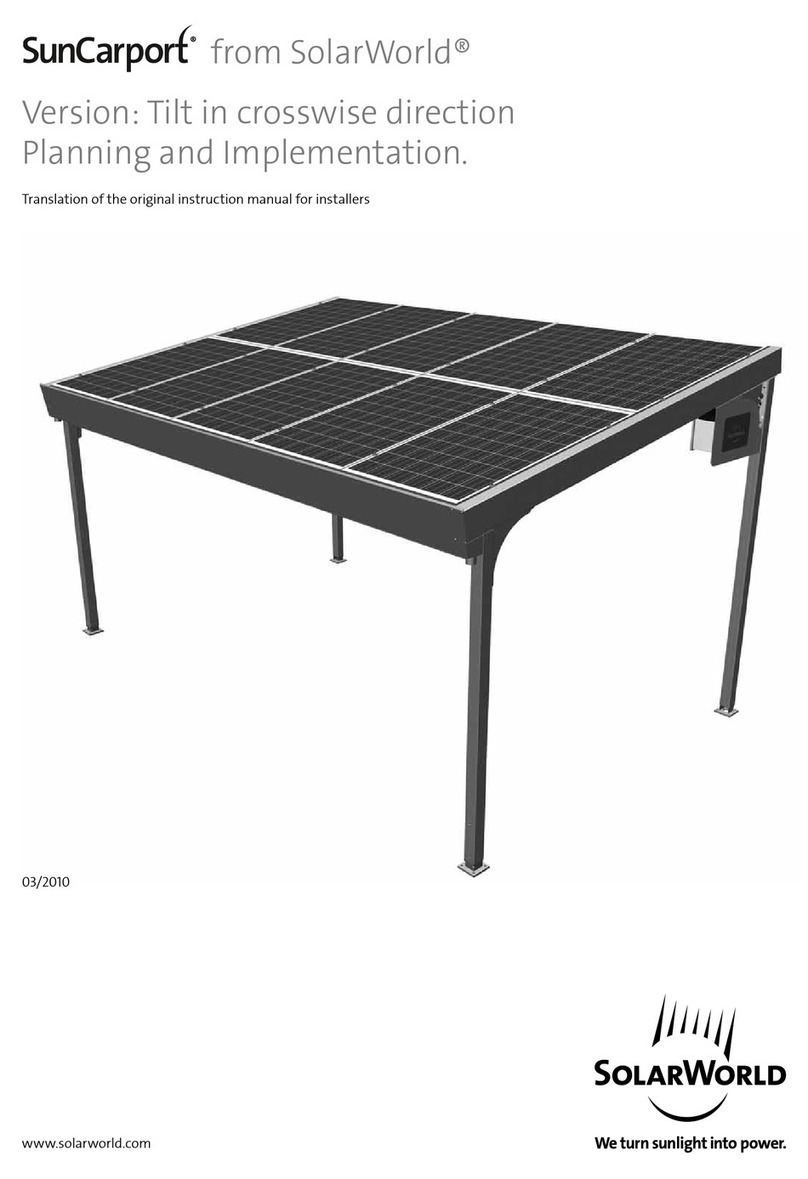
SolarWorld
SolarWorld SunCarport Planning and implementation guide
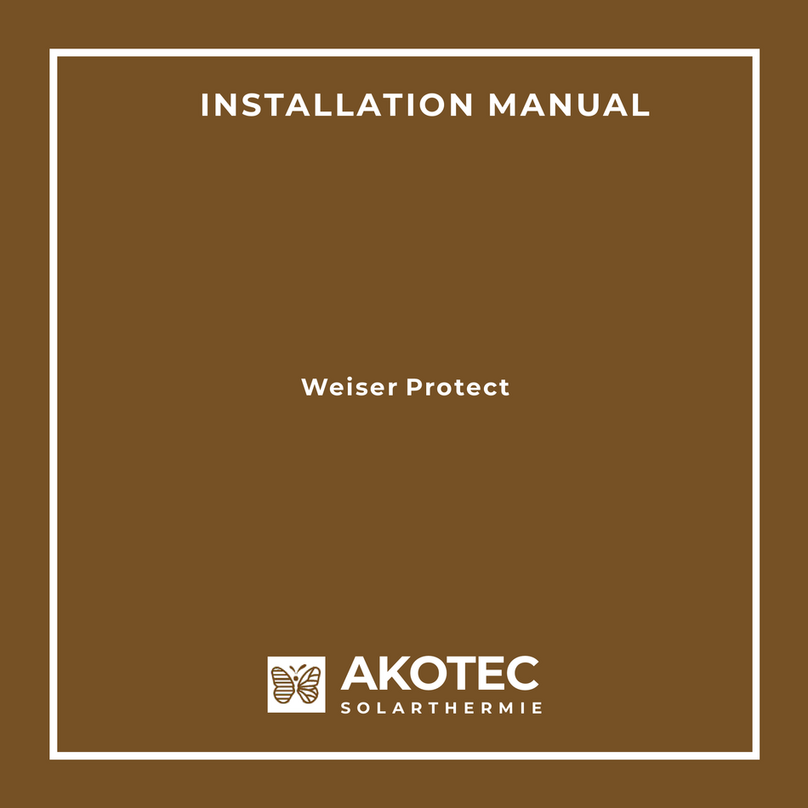
AkoTec
AkoTec Weiser Protect installation manual

Viessmann
Viessmann VITOSOL-F installation instructions
